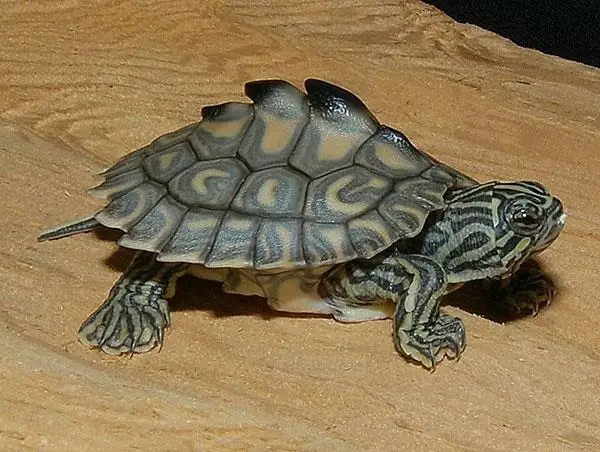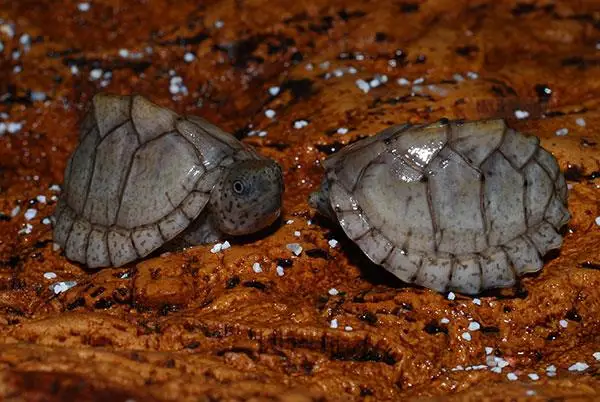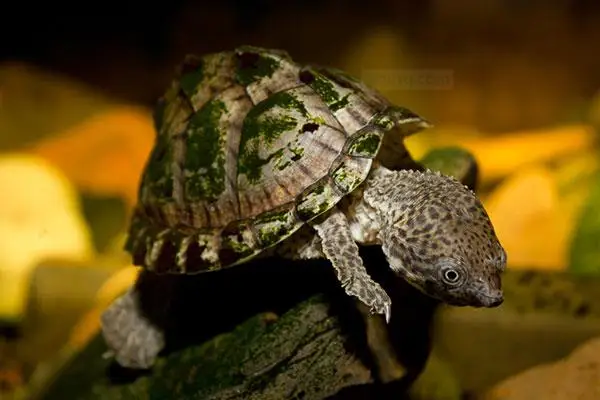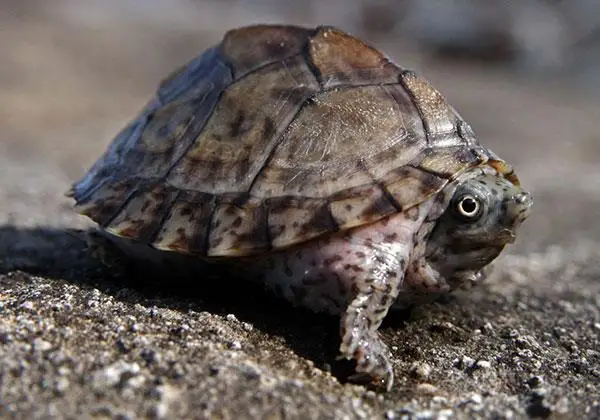Variety Overview
English Name: Razor-backed Musk Turtle
Alias: Razor Turtle
Origin: Southern Mississippi
Price: about $22~$52
Size: 10~14.9 cm (4~5.9 inches)
Lifespan: 15~20 years
Morphological Features and Identification
The Razor-backed Musk Turtle’s carapace features prominent ridges that form steep slopes. Its scutes range from light brown to light orange, adorned with dark spots or radiating stripes and dark edges that may fade as they age. The plastron is yellow and lacks a gular scute, resulting in just 10 scutes.
In adult turtles, lateral vertebrae traces are hard to find on their carapace. The first vertebral scute is elongated and narrows towards its front but does not touch the second marginal scute. The second vertebral scute’s length varies; it can be almost as long as it is wide or wider than its length. Typically, the last three vertebral scutes are broader than they are long, with the fifth one expanding laterally towards the back.
The carapace generally exhibits light brown and orange hues with noticeable black spots or radiating stripes; each scute has a black border at its rear which fades over time. Unlike mud turtles and other musk turtles that have 11 plastral scutes, this turtle has only 10 due to its lack of a gular scute. An indistinct hinge exists between pectoral and abdominal scutes with a small notch at the end of the anal scute. Plastral sizes rank as follows: intergular > abdominal > pectoral > humeral > anal.
The Razor-backed Musk Turtle’s head is moderately sized with a prominent mouth and slightly hooked upper jaw. Its beak shield above the mouth forks into two parts while its skin appears light gray or brownish-pink dotted with black spots. Its nose extends slightly like a tube while barbels grow on its chin.

Maintenance Tips
Razorback musk turtles thrive in deep water settings and are adept swimmers. Therefore, creating an appropriate environment is crucial when caring for them.
Space:
A 30-gallon tank is adequate for a single razorback musk turtle. If you plan to keep more than one, you’ll need to increase the tank size accordingly. It’s always better to have multiple sections if possible since these turtles are quite active and will make full use of the available space.
Water Quality:
A powerful filtration system is recommended as these turtles tend to be messy eaters, which can quickly degrade water quality if not properly filtered.
Hiding Spots:
Given their naturally shy nature, adding rocks and aquatic plants to the tank can provide a sense of security, particularly for younger turtles.
Basking Area:
You can create basking spots with rocks that protrude from the water surface. For juveniles, floating aquatic plants are preferable as basking areas.

Feeding Techniques
The Razorback Musk Turtle has a fairly straightforward diet and tends to prefer meat-based foods. When caring for them, you can feed them small fish, shrimp, and lean meat. It’s important to vary their diet to ensure they receive balanced nutrition. Be sure to mix different types of food together when feeding. If their diet is too monotonous over time—especially if it consists mainly of commercial turtle food—they may become picky eaters and less inclined to eat certain foods.

Breeding Insights
Female razor-backed musk turtles (Sternotherus carinatus) reach sexual maturity at around 10 cm (approximately 4-5 years), while males take about 5-6 years and achieve sexual maturity when their carapace measures between 10-12 cm. Male sperm cells are active from June to mid-August, peaking in August when the testes are fully enlarged. Although the testes start shrinking from late August to mid-September, mature sperm continues to be transported to the epididymis until December regardless of size reduction. From January to April, sperm activity is generally low but starts entering the vas deferens in March and April. For females, oocyte growth slows down between September and November and may extend into February of the following year. Oocytes enlarge between March and April and develop most rapidly in May and June before ovulation occurs; however, some unfertilized oocytes continue growing through July and August.
Courtship and mating typically occur in spring for razor-backed musk turtles as well. Eggs are laid between April and June after fertilization within the female’s body, with each clutch usually containing 2-4 white, fragile oval-shaped eggs laid annually during these months. Hatchlings that are artificially incubated in August or September have carapace lengths ranging from 23-31 mm with three distinct vertebral bones.
